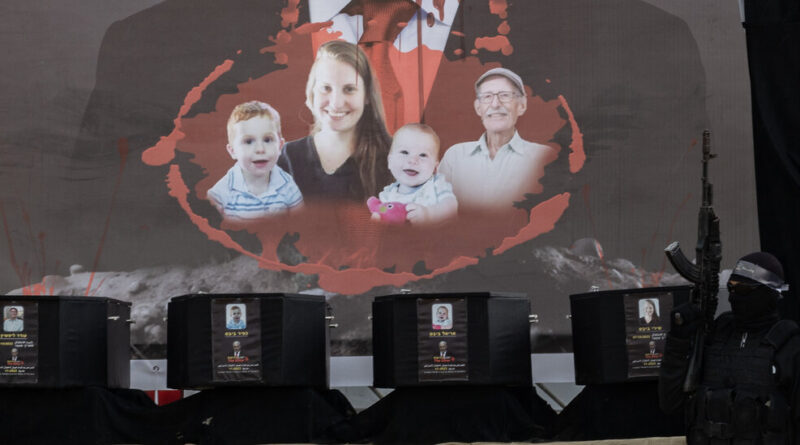Hamas Releases Bodies of 4 Israeli Hostages
Hamas handed over on Thursday what it said were the remains of four Israelis taken hostage during the Oct. 7, 2023, attack on Israel, including two young children whose abduction was widely seen as emblematic of the viciousness of the Hamas assault.
But early on Friday morning, the Israeli military said that only three of the bodies belonged to the hostages slated to be handed over. They were Oded Lifshitz, 83, a retiree and a peace activist; Ariel Bibas, 4; and Kfir Bibas, 10 months old; according to Israeli officials.
The fourth body was supposed to be the children’s mother, Shiri Bibas. But Israeli forensic testing found it did not belong to her, the Israeli military said, describing it as a “violation of the utmost severity” of the ongoing cease-fire. The claim threw the truce’s next steps into doubt after an already tense day that had ignited a torrent of emotion in the country.
Hamas said the four hostages were killed by Israeli airstrikes. The Israeli authorities said the two Bibas children were “brutally murdered by terrorists,” and that Mr. Lifshitz had been “murdered in the captivity of Palestinian Islamic Jihad” without providing further details. Neither claim could be immediately verified.
Crowds of Palestinians had gathered near the southern Gaza city of Khan Younis to watch the theatrical handoff staged by Hamas that morning: Four coffins placed on a stage in front of a cartoonish, vampiric picture of Benjamin Netanyahu, the Israeli prime minister. Triumphant music thumped in the background.
One casket bore a picture of Kfir Bibas, who was less than 9 months old when he was kidnapped. A few yards away, a poster threatened that if Israel went back to war against Hamas, even more hostages would return in coffins.
Miles away, Israelis watched the scene unfold in horror and anguish, a sharp contrast to the catharsis evoked by the recent releases of hostages who had survived. Israel’s leaders had vowed to topple Hamas and bring home the roughly 250 hostages the militant group and its allies abducted in October 2023.
But some of those taken captive are now coming home dead.
Critics in Israel say Mr. Netanyahu shares at least part of the blame, arguing that he pressed on with his campaign against Hamas rather than agreeing earlier to a cease-fire that would have saved some lives.
And despite more than a year of devastating war, Hamas’s show of force at the exchange demonstrated that the group was still very much in charge in Gaza. Scores of gunmen — most clad in green Hamas headbands — patrolled the area around the handoff.
On Thursday, the coffins containing remains were the latest props. Volker Türk, the United Nations high commissioner for human rights, called the display “abhorrent and cruel,” adding that it “flies in the face of international law.”
Israel and Hamas are now in the final weeks of a 42-day cease-fire that began in mid-January. As part of the truce, Hamas agreed to turn over 25 living Israeli hostages and the bodies of eight others in exchange for more than 1,500 Palestinian prisoners held by Israel.
In exchange for the bodies, Israel was expected on Saturday to free women and minors from Gaza who were detained during the war, generally without formal charges. But the latest accusations from Israel over the failure to turn over Ms. Bibas’s body threw that into doubt.
The Hamas-led surprise attack in October 2023 killed about 1,200 people, including Ms. Bibas’s parents, according to Israel. Israel’s relentless campaign against Hamas in Gaza quickly followed, killing tens of thousands of Palestinians and leaving much of the enclave in ruins.
In Israel, right-wing politicians, including Mr. Netanyahu, reiterated furious calls for revenge against Hamas in the wake of the handover. Others saw the return of the bodies as another sign of how important it was to immediately bring home the remaining captives.
“Next to the sadness, it underlined to me that the most critical thing now is to bring them all back,” said Bar Goren, 24, whose parents were both killed in the Oct. 7 attacks. “Everyone deserves this closure.”
Isaac Herzog, the Israeli president, said “there are no words” for the agony of seeing the coffins. Many Israelis are now familiar with the names and faces of the hostages, whose images have been ubiquitous in the country since their abduction.
“Our hearts — the hearts of an entire nation — lie in tatters,” Mr. Herzog wrote on social media. “On behalf of the State of Israel, I bow my head and ask for forgiveness. Forgiveness for not protecting you on that terrible day. Forgiveness for not bringing you home safely.”
Ms. Bibas’s husband, Yarden Bibas, was also abducted. In footage from the scene that is now seared into Israel’s national memory, a terrified Ms. Bibas — covered with a blanket — could be seen clutching Ariel and Kfir to her chest as she is taken away by armed militants.
In November 2023, Hamas published a statement announcing the deaths of Ms. Bibas and the two children. The group also published a propaganda video featuring a sobbing Mr. Bibas, while still in captivity, responding to the news. Human rights groups have said such videos amount to war crimes.
Mr. Bibas was freed in early February as part of the ongoing cease-fire agreement.
Mr. Lifshitz, a retired journalist, was taken alongside his wife, Yocheved Lifshitz. Hamas later freed her for what it said were “humanitarian reasons” but refused to release her husband. Before the war, Mr. Lifshitz had volunteered to drive Gazans seeking medical treatment in Israel to hospitals.
Both Israelis and Palestinians have seen emotional homecomings in recent weeks. Israeli hostages, many of them thin and pale, reunited with their families after many months in Hamas’s warren of underground tunnels.
And Palestinian prisoners — some of whom also emerged from Israeli jails appearing gaunt — also embraced loved ones. Some had been serving life sentences for deadly attacks against Israelis, while many others had not been charged with any crime.
On Saturday, Hamas had been expected to free the last six living hostages covered in the first phase of the cease-fire in exchange for more Palestinian prisoners. The remains of four others will be released the following weekend.
It is unclear now whether those exchanges will go forward as planned. But even if both sides manage to surmount the latest obstacle, the future of the truce after the first stage, set to expire in early March, is still shrouded in uncertainty.
Israel and Hamas have not agreed on terms to extend the agreement into a new phase that would conclusively end the war, free the remaining hostages and see a full withdrawal of Israeli forces.
President Trump has pressured both sides to clinch such a deal. But Israel has refused to countenance any Hamas control in Gaza, while Hamas has shown little appetite for disbanding its battalions of armed fighters or sending its Gaza leaders into exile.
Steve Witkoff, Mr. Trump’s Mideast envoy, said during a conference in Miami Beach on Thursday that reaching the next stage of the deal would be difficult, in part because of Israel’s red line on Hamas governance.
“It’s hard to square that circle,” Mr. Witkoff said. “But we’re making a lot of progress in the conversations and hopefully it will lead to some good things, good results.”
Kate Kelly contributed reporting from Miami Beach, Florida.





